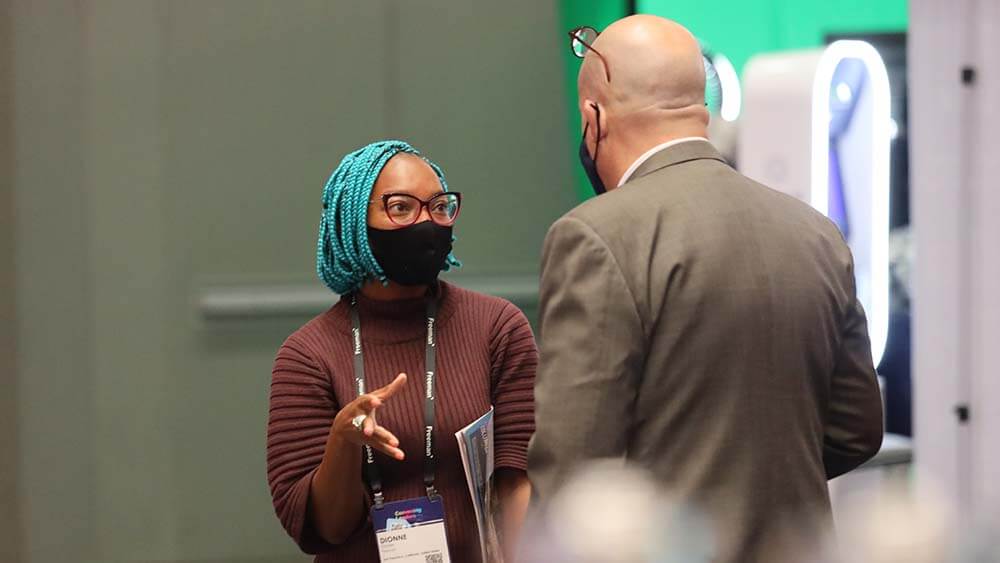
Liminal spaces — the transitional spaces such as corridors, hallways, elevators, and escalators — can be as important to the event attendee’s experience as the big rooms where sessions take place. (Jacob Slaton Photography)
“I miss the serendipity of in-person events.” I must have heard this statement a million times during the pandemic. It’s true — I’ve missed that, too.
I kept thinking about it. What is it that we really miss? Is it the 10-point font on a bulleted PowerPoint presentation nobody can read? Is it the crammed chairs stuck to one another so that we can fit as many people as possible in a room?
We can all agree that this is not what we loved about in-person events.
It must be the keynote atmosphere then. That’s it, it must be that. Yet, at the first in-person event I attended since the pandemic, I was asked to sit for an hour-and-a-half in a dark room listening to some famous person. Trust me, that didn’t give me any “finally we are back!” type of feeling.
Then something happened.
On the way out from the keynote in a corridor, I bumped into someone I follow on social media whom I had never met in person. What a great moment! We exchanged stories about the pandemic, gossiped about the industry, and caught up on our professional careers.
Bingo. That was the feeling I was missing. It was about the corridor, not the big room.
Enter the concept of liminal spaces. You can read more about what this means on Wikipedia. Let’s refer to these spaces as transitional spaces such as corridors, hallways, elevators, and escalators.
Liminal spaces are places of change, places where we feel uncomfortable because they are in-between two moments. They are temporary channels that enable us to go from one place to another.
Digging deeper into the role of these spaces, researchers have identified “liminoid experiences” as tools of evasion and places for a subversion of the rules. The example they provide? Nightclubs.
Wait. Networking parties were another big in-person experience we were missing during the pandemic.
Double bingo (is there such thing as double bingo?).

“Re-introducing a million speakers and sessions after the content overload we experienced during the pandemic can be dangerous to the wellbeing of our attendees. The desire for liminality is at an all-time high.” — Julius Solaris, VP of marketing strategy at Hopin
Adjust Your Event Design Tactics Towards Liminality
Liminality is an important event element that has a significant role in the way you design virtual events. Yet to think that in-person events make good use of liminal spaces is disingenuous at best. The fact we refer to serendipity means that in many cases there wasn’t intentional design — meeting people was happenstance.
The question then is: What can you do to ensure serendipity and subversion of the rules (aka war on boredom) at your virtual event? Planned serendipity — the oxymoron we should live by when we think about virtual events. It means planning moments for unexpected connections. A listen party with a DJ, a yoga or meditation session, and a breakout room on mental health during an engineering event.
Some of the options above may feel boring to you as you read them. That’s the thing. Planned serendipity moves fast online. Novelty is key to making us feel uncomfortable. And when we feel uncomfortable, we explore.
You should search for what challenges your audience sufficiently enough. Something that hasn’t been done before in your industry.
Platforms can be of great help with that. Be honest, how many times did you pass on including the networking module on your virtual event platform? Time to use it strategically for your attendees.
It always starts with event design and it never ends with virtual events.

Hopin offers a networking module that enables online participants to be randomly connected to each other in a virtual equivalent to meeting up in a corridor at a physical event.
Liminality at In-person Events
Many in-person events miss out at the opportunity that liminoid experiences bring to attendees. The rush to in-person events when events reopened has been, in some cases, a lost chance to change the way we plan events.
Re-introducing a million speakers and sessions after the content overload we experienced during the pandemic can be dangerous to the wellbeing of our attendees. The desire for liminality is at an all-time high.
That means saying yes to the networking party and the extended coffee breaks. No to excessive content.
Take IMEX America for example. They always do a great job of using hallways next to education rooms with a multitude of activations that can often be more engaging than the actual sessions. There are places where you can pet and hold puppies, refresh with water stations, relax at rest areas, recharge at meditation rooms, get professional headshot stations, and think about environmental concerns at sustainability corners. You name it — being there, I have connected or re-connected with five people in an hour. That didn’t happen nearly as much in the session I attended afterwards.
Serendipity can be inserted into content as well. Breakout rooms with discussion-driven content are a great opportunity to enable people listening to connect with each other. This is a good strategy for both in-person and virtual events.
What’s Next?
Ask yourself what your attendees want — the cliche of cliches when it gets to event strategy, I know.
However, asking ourselves this question these days is crucial for the success of our programs. Mostly because our needs as attendees have changed more during the past year than in the past decade. It’s time for a thorough due diligence.
You may find that your community cares about connection more than ever. They may want to have fun and stop thinking about the collective misery we all have had to go through.
They may also seek meaning and content but their preferred learning style might have dramatically changed. Learning by connection may be as important as ever. Group work over individual assignments.
As always, events are very different and serve different purposes. You may also find that the pre-pandemic way of doing things works very well for your audience. That is great. Keep doing it.
If things, on the other hand, are not looking up for your audience and your engagement numbers are going down, a strategy refresh with liminality at its core may be the way to go.
Julius Solaris is VP of marketing strategy, events at event tech company Hopin, which offers a networking module that enables online participants to be randomly connected to each other in a virtual equivalent to meeting up in a corridor at a physical event.
